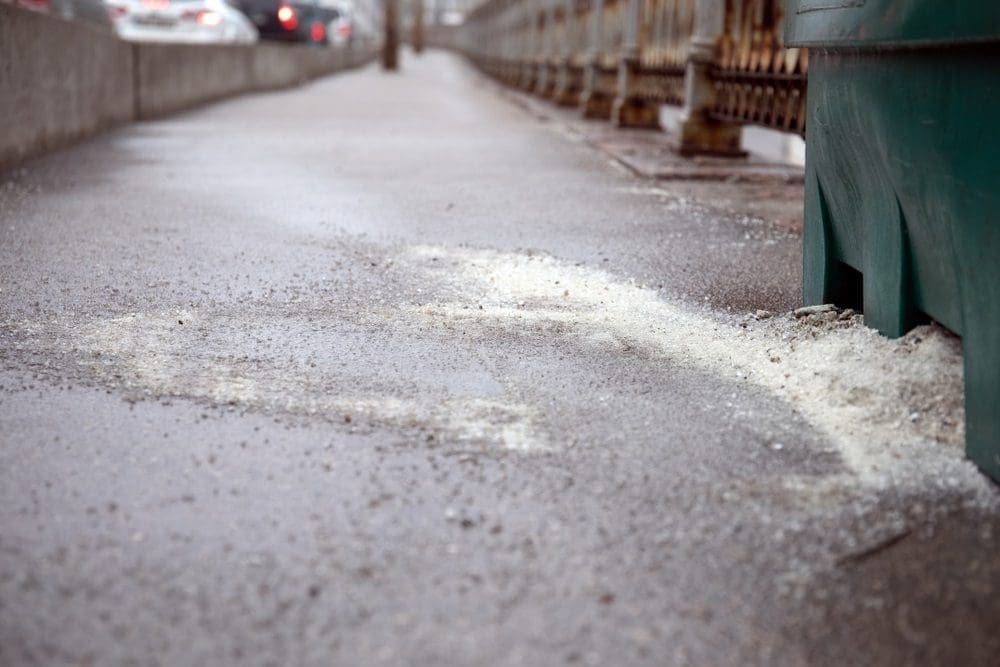Any business owner familiar with the chaos that slippery roads and pavements can cause knows at least a little about the deicing agents commonly used on the roads and sidewalks in winter. Calcium chloride and sodium chloride (or rock salt) are easily the most widely used, and both have their own unique properties.
Deciding which deicing agent – calcium chloride vs. rock salt – is right for you depends entirely on your circumstances and the weather you experience. Sometimes one will vastly outperform the other, and sometimes a combination of both calcium chloride and sodium chloride is the perfect solution.
At Earth Development, we consider your exact circumstances and the weather you’re facing before making the right decision. We’re also passionate about making sure all of our customers are fully informed about the products we use.
Let’s take a look at the differences between these two popular deicers so you can determine what’s best for you.
What Is Sodium Chloride?

Sodium chloride, also known as table salt or rock salt, is an ionic compound made up of electrically charged sodium and chloride ions bonded together. The chemical formula for pure sodium chloride is NaCl, representing one sodium atom bonded to one chlorine atom to form a neutral molecule.
When sodium chloride dissociates in water, it separates into sodium (Na+) and chloride (Cl-) ions which conduct electricity, making salt water an electrolyte solution. Sodium chloride has a high boiling point of 1413°C and is key for animal health and many industrial applications, including ice melt.
Pros of Sodium Chloride
- Affordable and readily available. Sodium chloride, also known as rock salt, is one of the most common and affordable deicers available. It can be found at most hardware stores and home improvement centers.
- Effective at melting ice. Sodium chloride is effective at melting ice at temperatures as low as 15°F. It isn’t as effective as calcium chloride at lower temperatures, but it’s still a good option for most areas.
- Safe for pets and plants. Sodium chloride is relatively safe for pets and plants when used as directed. It’s not as harmful as other deicers, such as calcium chloride, and it is not likely to cause any lasting damage.
- Easy to use. Sodium chloride is easy to use and apply. It can be spread by hand or with a snow blower. It’s also relatively safe to walk on, even when wet.
Cons of Sodium Chloride
- Not as effective at lower temperatures. Sodium chloride isn’t as effective at melting ice at temperatures below 15°F. If you live in an area with cold winters, you may need to use a different deicing agent.
- Corrosive to concrete and metal. Sodium chloride can cause pitting and staining on concrete and metal surfaces. Be sure to avoid contact with these surfaces as much as possible.
- Can be harmful to plants. Sodium chloride can be harmful to plants, especially when used in large quantities. Avoid using sodium chloride near plants.
- Can be toxic to pets. If ingested, sodium chloride can be toxic to pets. You’ll want to keep sodium chloride out of reach of pets.
What Is Calcium Chloride?

Calcium chloride is an inorganic salt made up of calcium and chlorine atoms. It commonly exists as white salt crystals composed of ionic bonds between positively charged calcium ions and negatively charged chloride ions. When dissolved in water, calcium chloride breaks into its calcium and chloride ions. It has many industrial uses including road de-icing and dust control due to its ability to attract moisture.
Pros of Calcium Chloride
- Melts ice at lower temperatures than other deicers. Calcium chloride can melt ice at temperatures as low as -25°F, while rock salt only works down to 20°F. This melting point makes calcium chloride a good choice for areas that experience extreme cold weather.
- Melts ice faster than other deicers. Calcium chloride forms brine rapidly, which lowers the freezing point of water and melts snow and ice quickly. This can be especially helpful in areas where ice needs to be melted quickly including sidewalks and driveways.
- Generates heat as it dissolves. Calcium chloride actually generates heat as it dissolves, which can help to melt ice even faster. This contrasts with other deicers, which need to draw heat from their surroundings to melt ice.
- Less harmful to plants than other deicers. Calcium chloride is less harmful to plants than other deicers, such as rock salt. However, you’ll still want to use calcium chloride carefully, as it can still damage plants if it’s over-applied.
- Less corrosive to metal than other deicers. Calcium chloride is less corrosive to metal than other deicers, such as rock salt, but it still shouldn’t come into contact with metal. This can cause pitting and staining.
Cons of Calcium Chloride
- Harmful to pets. If ingested, calcium chloride can cause vomiting, diarrhea, and other health problems for your pets.
- Harmful to aquatic life. Calcium chloride can pollute waterways and harm fish and other aquatic animals.
- Corrosive to metal. Calcium chloride can cause pitting and staining on metal surfaces.
- Drying to plants. Calcium chloride can leach moisture from plants, causing them to dry out and die.
- It can be messy. Calcium chloride can leave an unsightly white residue on surfaces that can be difficult to remove.
Calcium Chloride vs. Sodium Chloride: The Key Differences
Deciding between calcium chloride and sodium chloride is a frequent dilemma when trying to clear snow and ice safely. We’ve compared their distinct properties to help you select the optimal ice-clearing solution for your needs.
1. Cost: Calcium Chloride vs. Sodium Chloride — Which Is Cheaper?
The cheaper and more accessible option is sodium chloride or rock salt. This is an abundant substance found all over the world, meaning high shipping costs typically aren’t tacked onto the price. For most people, rock salt is an ideal solution because it’s affordable, accessible, and effectively lowers the freezing point of water.
It’s easily the most affordable deicing agent out there.
More affordable: Sodium Chloride
2. Easiness of Application: Calcium Chloride vs. Sodium Chloride
When it comes to ease of application, sodium chloride in rock salt form is generally the more convenient option for ice melting. Rock salt is readily available at most stores, easy to spread by hand or with a spreader, and can be applied by anyone without special equipment.
Calcium chloride may require some additional effort to obtain and apply properly. Although it comes in easy-to-spread pellet form, calcium chloride isn’t as widely available as rock salt and it typically needs to be purchased from specific retailers or suppliers.
Easier to use: Sodium Chloride
3. Effectiveness: Ice Penetration Rate and Temperature Considerations

- Beyond price, the ice penetration rate and the temperatures at which the deicing agents work are extremely important. Calcium chloride has the edge with its ability to melt ice at temperatures as low as -20°F.
- Rock salt can only melt ice and snow at temperatures above 20°F, meaning it’s ideal for mild winter weather but not for the much colder temperatures experienced in some states. Given that most states in the north and Midwest drop below this temperature in the winter, calcium chloride has a real advantage here with its much lower freezing point – but only needs to be broken out when the temperatures get that low.
More effective: Calcium Chloride
4. Safety: Calcium Chloride vs. Sodium Chloride
Vehicle: Which One Is Less Corrosive?
- When it comes to vehicle safety, calcium chloride has advantages over sodium chloride for ice melting. Calcium chloride is much less corrosive, making it a safer choice around vehicles and metal components.
- Sodium chloride in rock salt form can damage auto finishes and corrode metal when exposure is prolonged. The sodium ions are particularly corrosive to alloys containing copper, aluminum, and iron.
Calcium Chloride vs Sodium Chloride: Which One Is Safier for Concrete?
- Calcium chloride is far less abrasive and corrosive to concrete. It penetrates more slowly and triggers less freeze/thaw deterioration. This makes calcium chloride a good choice for use on driveways, sidewalks, steps, and other concrete surfaces prone to icing issues.
- Sodium chloride, on the other hand, can damage concrete surfaces through repeated freeze/thaw cycles. The salt penetrates porous concrete and causes subsurface damage as water freezes and thaws.
Which De-Icer Is More Eco-Friendly and Safe for Landscaping?
- Calcium, on the other hand, is an essential plant nutrient that most vegetation can tolerate in moderate amounts. Calcium chloride is less likely to burn when properly applied around trees, shrubs, lawns, and sensitive roots.
- The sodium ions in rock salt are readily absorbed by plant roots and foliage, disrupting hydration and leading to scorched leaves or death.
More safe: Calcium Chloride
Calcium Chloride vs. Sodium Chloride: General Tips

The right way to use calcium chloride or sodium chloride to melt ice depends on a few factors, including the temperature, the surface you’re treating, and the amount of ice you need to melt.
- Apply the deicing agent to dry surfaces. If you apply it to wet surfaces, it won’t be as effective at melting ice.
- Apply the deicing agent in a thin layer. A thick layer can be more corrosive to surfaces.
- Rake or sweep away excess deicing agent once the ice has melted. This prevents it from becoming a slippery mess.
How Much Do You Need?
Sodium chloride needs to be applied regularly throughout a weather event – as does calcium chloride – but will typically need to be applied in larger quantities. This often isn’t a problem owing to the affordability of this agent, but calcium chloride is more efficient.
By melting water in lower concentrations, Calcium Chloride doesn’t need to be applied in quantities quite as substantial.
What Is the Best Choice?
Are you still wondering if calcium chloride is better than sodium chloride? Businesses that don’t often experience temperatures below 20°F and which are not concerned about impacting soil in lawns or flower beds will be well served by regular sodium chloride. However, for businesses looking to minimize the impact of freezing temperatures, either calcium chloride or a combination of both will provide the reliable deicing effect that you need.
Solely on a matter of price, a combination of both agents is always a good choice.
How About Using Both?
Sometimes this is absolutely the best idea. Combining these two salts reduces your expenditure and reduces the chance of ice bonding with outdoor surfaces at a variety of temperatures.
The cheap nature of sodium chloride, combined with its effectiveness and the unique benefits of calcium chloride makes combining these two solutions ideal for many kinds of businesses.
Why Not Leave It to the Experts?
The easiest way to make sure that the right deicing agent is used on your property is to leave it to the experts!
At Earth Development, we have professional, local snow removal contractors across the Midwestern United States. With all their own equipment and years of experience, our contractors will ensure that your property is prepared for the winter months ahead providing professional snow and ice removal services.
For more information or even a free quote, don’t hesitate to reach out today!
